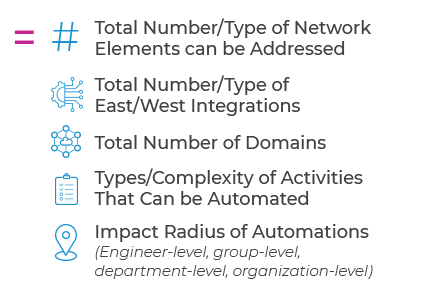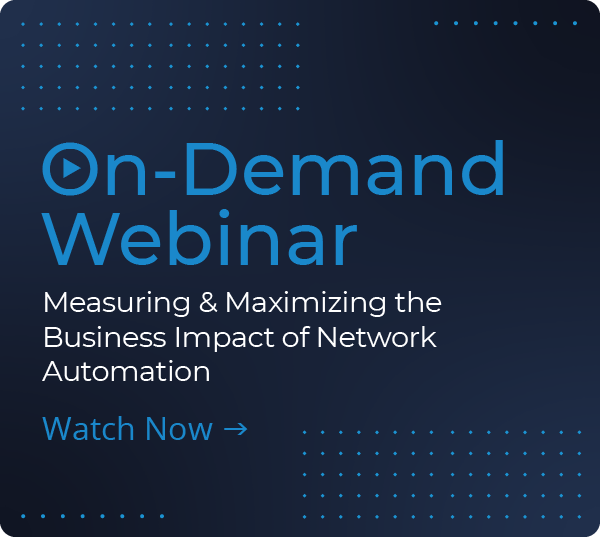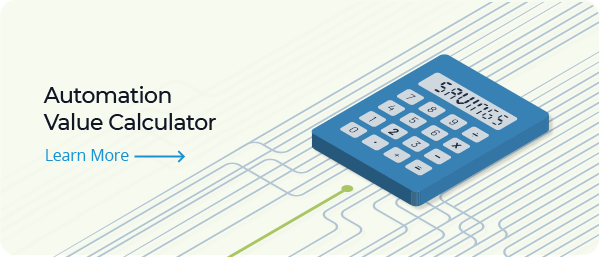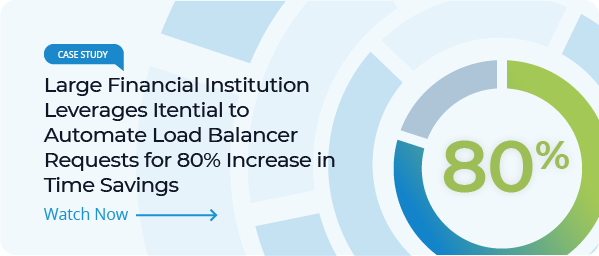Measuring the Business Impact of Network Automation
Understand how to uncover the key metrics that can help teams measure the impact and build their business case for network automation.
Automation Factory
Why a Metrics Driven Approach to Network Automation?
It’s critical for network teams to start thinking about how network automation will not just help them to do their jobs more effectively, but how automation will benefit their business.
- Quantify Impact of Your Automation – As the automation industry emerges from infancy, companies must start focusing on maximizing business impact.
- Enable Informed Automation Decisions – High-level goals like “OPEX Reduction” or “Go Faster” are directional, but not particularly useful for decision making.
- Create a Common Language – Automation teams and internal sponsors can gain from using a common set of metrics that more accurately capture the business impact of automation.
- Improve Selection & Performance of Automation – These metrics can be used both as an aid for evaluating/comparing automation solutions, and as a method to measure and report on automation implementations.
The Network Automation Metrics That Maximize Business Value
Workload unit cost focuses not only on the total cost of the automation system, but on the cost of that system in relation to how many activities it has completed, or will complete. The more activities your automation completes, the lower the workload unit cost.
Total Costs vs. Incremental Costs
Both are important, but must look at total costs when making the business case:
- Include the costs of systems, tools, and human effort required to perform the activity.
- Include the costs to build and maintain the system, along with the human effort, etc.
- Three or five year view is typical.

Efficiency and productivity focuses on the quantity of people involved in, and required to, perform any manual steps that still remains in your automation. It can be based on the number of activities that can be performed by a single engineer or a group.
Current Productivity vs. Projected Productivity
- Pay close attention to the differences in options – How much handholding to feed the system?
- Manual automation vs. end-to-end automation:
- Where does the data come from? Spreadsheets/email vs. systems
- How does it get into the system? Manual vs. automated ingestion/transformation
- 10% vs. the 100% is a major differentiator for productivity.

Time-to-complete focuses on the total elapsed time for an activity to be completed – from the point when the activity is requested to the point when it is finished, including any idle time due to handoffs, delays, approvals, and scheduling.
Optimize Your Time-to-Complete
- Evaluate automation solutions on their relative abilities to provide the shortest feasible time-to-complete.
- Some factors affecting time-to-complete are outside of the scope of any automation system, including physical activities such as hardware installations, wiring, etc.
- Specifically, evaluate how much of the current process can be automated? (10% vs. 100%)

Versatility and reach focuses on activities that can be expressed as a quantity but should also be characterized by the type and complexity of the activities performed: low complexity use case vs. high complexity use case.
Other factors that impact complexity:
- Reach
- Scale
- Domain Agnostic
- Recommendation

How to Use the Metrics for Evaluating Automation Approaches
Consider the following when evaluating and selecting automation technology for your automation approach:
Workload Unit Cost
![]()
Does the capacity and cost of the option provide the lowest Workload Unit Cost?
Efficiency & Productivity
![]()
Does the option require heavy human interaction or can it run unattended and maximize productivity?
Time-to-Complete
![]()
Does the option have the ability and connectivity to optimize time-to-complete?
Versatility & Reach
![]()
Does the option have the capability to touch as much of the network and business as possible? Can it automate the variety of use cases required by the business?
Aligning Metrics to Financial Analysis
By combining metrics with a thorough financial analysis, leadership will have the tools to both select and measure the right automation solution. Itential recommends an iterative approach to this analysis:
- Preliminary Analysis to identify and prioritize based on rough order-of-magnitude impact.
- Detailed Analysis to improve precision for high-potential use cases and to capture both benefits and costs.
- Analysis Validation to quantify the amount of value realized and to provide empirical data for future cases.
Driving Tangible Business Value for Network Automation Use Cases with Itential
Itential customers experience immediate return on investment and greater velocity gains through automating network operations, experiencing such results as:

Additional Resources
Blog: Uncover Your Top Network Automation Use Cases with Itential’s Automation Value Calculator Blog: The 4 Key Metrics Needed to Build Your Business Case for Network Automation White Paper: How to Build an Automation Factory to Transform Network Operations Blog: How to Identify the Financial Impact of Network Automation Use Cases Blog: The Three Phased Approach to Evaluating Network Automation Use CasesGet Started with Itential
Start a 30 day free trial, or contact us to discuss your goals and how we can help.



